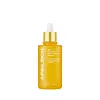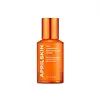What's inside
What's inside
 Key Ingredients
Key Ingredients

 Benefits
Benefits

 Concerns
Concerns

 Ingredients Side-by-side
Ingredients Side-by-side

Methylpropanediol
SolventButylene Glycol
HumectantPentylene Glycol
Skin ConditioningBetaine
HumectantXylitol
HumectantSodium Hyaluronate
HumectantSodium Hyaluronate Crosspolymer
HumectantSodium Acetylated Hyaluronate
HumectantHydroxypropyltrimonium Hyaluronate
Hydrolyzed Hyaluronic Acid
HumectantLavandula Angustifolia Flower/Leaf/Stem Extract
MaskingPueraria Lobata Root Extract
HumectantPinus Palustris Leaf Extract
TonicUlmus Davidiana Root Extract
Skin ConditioningOenothera Biennis Flower Extract
AstringentCalendula Officinalis Flower
Skin ConditioningCitrus Sinensis Peel Oil Expressed
PerfumingAllantoin
Skin ConditioningPolyquaternium-51
Skin ConditioningGlyceryl Acrylate/Acrylic Acid Copolymer
HumectantAcrylates/C10-30 Alkyl Acrylate Crosspolymer
Emulsion StabilisingC12-14 Pareth-12
EmulsifyingXanthan Gum
EmulsifyingTromethamine
BufferingCitric Acid
BufferingMethylpropanediol, Butylene Glycol, Pentylene Glycol, Betaine, Xylitol, Sodium Hyaluronate, Sodium Hyaluronate Crosspolymer, Sodium Acetylated Hyaluronate, Hydroxypropyltrimonium Hyaluronate, Hydrolyzed Hyaluronic Acid, Lavandula Angustifolia Flower/Leaf/Stem Extract, Pueraria Lobata Root Extract, Pinus Palustris Leaf Extract, Ulmus Davidiana Root Extract, Oenothera Biennis Flower Extract, Calendula Officinalis Flower, Citrus Sinensis Peel Oil Expressed, Allantoin, Polyquaternium-51, Glyceryl Acrylate/Acrylic Acid Copolymer, Acrylates/C10-30 Alkyl Acrylate Crosspolymer, C12-14 Pareth-12, Xanthan Gum, Tromethamine, Citric Acid
Water
Skin ConditioningButylene Glycol
Humectant1,2-Hexanediol
Skin ConditioningNiacinamide
SmoothingCetyl Ethylhexanoate
EmollientDaucus Carota Sativa Seed Oil
EmollientCetearyl Olivate
Propanediol
SolventCarbomer
Emulsion StabilisingSorbitan Olivate
EmulsifyingTromethamine
BufferingHouttuynia Cordata Extract
Skin ConditioningEthylhexylglycerin
Skin ConditioningAdenosine
Skin ConditioningHydrolyzed Extensin
Skin ConditioningTricholoma Matsutake Extract
Skin ConditioningRhododendron Chrysanthum Leaf Extract
MaskingCitrus Aurantium Bergamia Fruit Oil
MaskingPogostemon Cablin Leaf Oil
MaskingSodium Hyaluronate
HumectantEucalyptus Globulus Leaf Oil
PerfumingHyaluronic Acid
HumectantHydrolyzed Hyaluronic Acid
HumectantCastanea Crenata Shell Extract
Skin ConditioningLavandula Angustifolia Flower Extract
CleansingCaprylic/Capric Triglyceride
MaskingMelaleuca Alternifolia Leaf Oil
AntioxidantPolyglyceryl-10 Oleate
Skin ConditioningCentella Asiatica Extract
CleansingCI 75130
Cosmetic ColorantWater, Butylene Glycol, 1,2-Hexanediol, Niacinamide, Cetyl Ethylhexanoate, Daucus Carota Sativa Seed Oil, Cetearyl Olivate, Propanediol, Carbomer, Sorbitan Olivate, Tromethamine, Houttuynia Cordata Extract, Ethylhexylglycerin, Adenosine, Hydrolyzed Extensin, Tricholoma Matsutake Extract, Rhododendron Chrysanthum Leaf Extract, Citrus Aurantium Bergamia Fruit Oil, Pogostemon Cablin Leaf Oil, Sodium Hyaluronate, Eucalyptus Globulus Leaf Oil, Hyaluronic Acid, Hydrolyzed Hyaluronic Acid, Castanea Crenata Shell Extract, Lavandula Angustifolia Flower Extract, Caprylic/Capric Triglyceride, Melaleuca Alternifolia Leaf Oil, Polyglyceryl-10 Oleate, Centella Asiatica Extract, CI 75130
 Reviews
Reviews

Ingredients Explained
These ingredients are found in both products.
Ingredients higher up in an ingredient list are typically present in a larger amount.
Butylene Glycol (or BG) is used within cosmetic products for a few different reasons:
Overall, Butylene Glycol is a safe and well-rounded ingredient that works well with other ingredients.
Though this ingredient works well with most skin types, some people with sensitive skin may experience a reaction such as allergic rashes, closed comedones, or itchiness.
Learn more about Butylene GlycolHydrolyzed Hyaluronic Acid is a form of hyaluronic acid. It is created by the hydrolysis of hyaluronic acid with a high molecular weight. Once created, Hydrolyzed Hyaluronic Acid has a low molecular weight.
Low molecular weight HA has been shown to hydrate and increase elasticity of the skin. Increasing elasticity is also associated with reduction of wrinkle depth.
One study found topical low molecular weight hyaluronic acid may be considered for the treatment of rosacea in the adult population. However, we always recommend speaking with a professional about your skin concerns.
Hyaluronic acids are a humectant. This means they draw moisture from the air. Hyaluronic acids help moisturize, soothe, and protect the skin.
Read more about other common forms of hyaluronic acid:
Learn more about Hydrolyzed Hyaluronic AcidSodium Hyaluronate is hyaluronic acid's salt form. It is commonly derived from the sodium salt of hyaluronic acid.
Like hyaluronic acid, it is great at holding water and acts as a humectant. This makes it a great skin hydrating ingredient.
Sodium Hyaluronate is naturally occurring in our bodies and is mostly found in eye fluid and joints.
These are some other common types of Hyaluronic Acid:
Learn more about Sodium HyaluronateTromethamine helps balance the pH and improve the texture of a product. It is synthetically created.
As an emulsifier, Tromethamine prevents oil and water ingredients from separating. This helps stabilize the product and elongate a product's shelf life. Tromethamine also makes a product thicker.
Tromethamine helps balance the pH level of a product. Normal pH level of skin is slightly acidic (~4.75-5.5). The acidity of our skin is maintained by our glands and skin biome. Being slightly acidic allows our skin to create an "acid mantle". This acid mantle is a thin barrier that protects our skin from bacteria and contaminants.
Oral Tromethanmine is an anti-inflammatory drug but plays the role of masking, adding fragrance, and/or balancing pH in skincare.
1,3-Propanediol, 2-amino-2-(hydroxymethyl)-
Learn more about Tromethamine